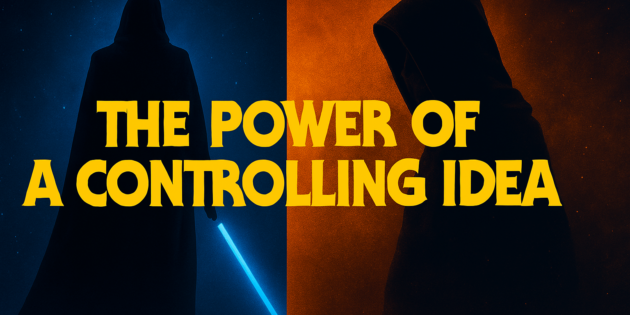When it comes to storytelling, few concepts are as powerful—and as misunderstood—as the controlling idea.
Coined by Robert McKee in his classic book Story: Substance, Structure, and the Principles of Screenwriting, the controlling idea is the thematic spine of a narrative. It’s not just what a story is about, but what it means. It’s the message the narrative delivers through the outcome of its plot. And when a controlling idea is strong, clear, and emotionally resonant? That’s when a story truly soars.
Let’s break this down with two examples from one of the most iconic franchises in pop culture: Star Wars.
Example 1: Star Wars: A New Hope
Let’s start with the OG.
One of the many reasons A New Hope became a global phenomenon is because it delivers a crystal-clear controlling idea:
“Good prevails over evil when heroes embrace their destinies.”
That’s it. Simple. Powerful. Instinctual.
You don’t have to think about this message when watching the film—you feel it in your gut. It taps into a timeless storytelling tradition that spans centuries.
Humanity has been telling some version of this tale since we first gathered around campfires. It’s mythic, it’s archetypal, and it’s baked into the structure of the film from the opening crawl to the final trench run to destroy the Death Star.
Example 2: Star Wars: The Last Jedi
Now let’s fast-forward to 2017.
When Disney purchased the Star Wars franchise from George Lucas and set out to continue the Star Wars saga, they wanted to bring it into the modern age.
With The Last Jedi, they made a bold, risky creative choice—and the results were… divisive, to say the least.
The controlling idea of The Last Jedi might be something like:
“In a morally gray world, good people win not by fighting what they hate, but by saving what they love.”
There’s actually something kind of beautiful about that. Philosophically, it’s rich. It flips the old good-vs-evil binary on its head and tries to engage with a more complex emotional landscape.
It’s also, like the film as a whole, a noble failure.
It is what I find so fascinating about The Last Jedi. The writer/director Rian Johnson swung for the fences… and struck out every single time.
Even this controlling idea, delivered nearly word-for-word in the film itself by the character Rose Tico, comes across as muddled.
Without the clear moral clarity of something like A New Hope, the audience is left grasping. In a world without defined good or evil, what exactly are we rooting for? The answer is fuzzy. The theme is admirable in theory… but hard to pin down in practice.
Why This Matters for Writers
Here’s the takeaway: a story doesn’t need to be simplistic, but it does need to be clear.
Your audience wants to feel like they’ve gone on a journey and arrived somewhere meaningful. They want the story to say something—even if they can’t always articulate what that something is.
A New Hope nails that. It delivers an iconic, emotionally satisfying controlling idea.
The Last Jedi aims high, but its message lacks punch, coherence, and resonance.
So if you’re writing your next novel, screenplay, or short story, ask yourself:
• What is the controlling idea?
• Is it clear?
• Is it emotionally resonant?
• Does the story’s outcome prove it to be true?
Because when your theme is locked in tight and supported by every story beat, your readers don’t just enjoy your story—they believe in it.
~~~
Kevin T. Johns is a writing coach, author, and story structure nerd who helps genre fiction writers craft compelling narratives with strong thematic cores—even if they’re not writing space operas (yet). Get his checklist for turning ordinary scenes into literary gold:







